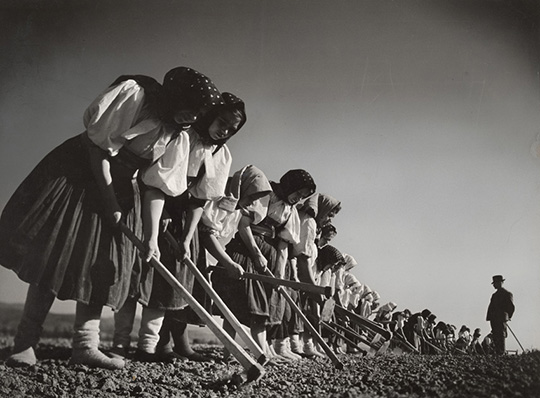Margaret Bourke-White
Margaret Bourke-White was an American Photojournalist born in 1904 in New York. Bourke-White is known for her work with Life magazine and being a female documentary photographer. She attended multiple Universities, ultimately taking up photography as a hobby which turned into her life long career. According to Encyclopedia of World Biography: "In 1934, in the midst of the Depression (a decade-long period of severe economic hardship in the 1930s), she earned over $35,000. But a Fortune assignment to cover the drought (a severe shortage of water) in the Midwest states opened her eyes to human suffering and steered her away from advertising work. She began to view photography less as a purely artistic medium and more as a powerful tool for informing the public".
Bourke-White first worked for Fortune magazine and then Life magazine. She traveled America documenting social struggles, racial struggles, tragedy and disaster. Later with Life magazine and the US Air Force she documented WWII. She traveled to Germany, Russia, France, and others with the American troops. According to Encyclopedia Britannica: “her transport ship was torpedoed and sunk, but Bourke-White survived to cover the bitter daily struggle of the Allied infantrymen in the Italian campaign.". According to Time: she was the first female photojournalists to cover WWII combat zones. Her last great effort in the war was documenting the suffering in concentration camps in Germany. After WWII she traveled to South Africa and Korea documenting more racial struggles and after math of war. She passed away in 1971, suffering from Parkinson's Disease.
Liberation of Buchenwald concentration camp
Photo by: Margaret Bourke-White
Image source:https://www.vintag.es/2012/04/liberation-of-buchenwald-april-1945.html
Year Created: 1945
Subject Expression: The expression of the main subject in the picture which is the man standing in front is very somber. The men are all sick, emaciated and are stacked in like sardines.
Quality of light: The quality of light is poor, as you can see the flash outline in the photo. It looks like a dark or poorly lit place, so the flash was the only source of light.
Black and white: The image was done in black and white, as that was the main way to develop in this time.
I cboose this image because of the intense feelings emitted from the faces of the men in the concentration camp.
Photo by: Margaret Bourke-White
Image source:https://news.syr.edu/2014/08/margaret-bourke-white-moments-in-history-opens-aug-19-51370/
Year Created: 1938
Depth of field: There is a long depth of field, as you look down the line of women. It shows how many women there was.
Use of lines: The linear formation of the women working and the strong lines of the tools they are using . The use of lines draws you into subject of the picture which is the working women.
Focus: It is more out of focus the farther down the line of women goes. The main two women in the start of the line are in focus, from there is gets out of focus.
I choose this image because of the image of women working, and the message it sends in this module on Feminism.
Photo by: Margaret Bourke-White
Image source:https://richflintphoto.blogspot.com/2010/07/profile-margaret-bourke-white.html
Year Created: 1936
Obvious main subject: The large tunnels take up most of the picture and they make a very prominent main subject.
Background: The background in this picture is blank, as it is a clear sky. The background being plain assists in moving peoples eyes to the size of the people in the bottom of the picture. The size of the people compared to the tunnels showcase the subject of the picture being the tunnels.
Keep it simple: This picture is a very simple subject, being the ends of tunnels with people next to them.
I choose this image as it is so profound with the size and shape of the tunnels.
Female discrimination in the job force
Female Police offers are generally the minority in the male dominated field. Women have faced great challenges attempting to be in the male dominated industry. This compares to the struggles women faced in attempting to be Photojournalists according to Professor Nordell's video. Female policer officers have reported discrimination, sexism and harassment by their male counterparts. Like Marion Post Wolcott's experiences in the Biographical essay, where she was harassed by the male Photojournalists and they even went as far as urinating in her developing chemicals. Females in the police force are challenged with command presence, as they will not be seen as authoritative. Female Photojournalists according to Professor Nordell in his video also struggled with being taken seriously as professional talent. Female Officers have made forward movements in their profession as female Photojournalists have.
.jpg)


No comments:
Post a Comment